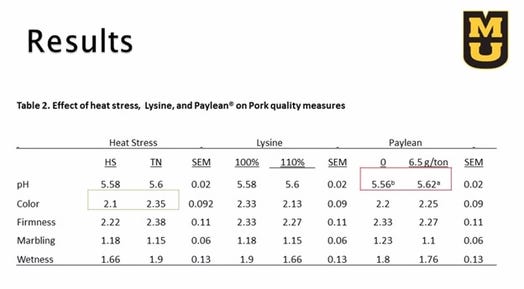Heat stress impact on subsequent growth and reproduction of offspring
The effects of thermal stress on pregnant females are just beginning to be understood.

All hog farms experience seasonal productivity lag and poorer reproductive performance during the hot days of summer. Heat stress can reduce feed intake, growth rate and reproductive performance. While swine herds of all sizes and stages of production are adversely affected by seasonal variation temperature, little tools are available to mitigate the impact. Therefore, the National Pork Board has invested in research projects to lessen seasonal productivity lags.
In the second webinar in a research series hosted by the NPB, Tim Safranski, University of Missouri animal science professor, explained the impact of heat stress on subsequent growth, composition and reproduction of offspring.
Focusing on the breeding herd, heat stress can negatively affect litter size, birth weight and semen production. Typically, the following heat stress problems occur in the female.
Delayed puberty
Weaker, shorter and more irregular cycles
Higher embryonic death
Increased stillborns
Increased aborts
Decreased lactation feed intake
Increased sow mortality
Past research has shown that heat stress can reduce birth weight. However, subsequent reproductive performance of piglets developing under heat stress conditions has not been reported and may magnify the true impact heat stress has on the U.S. swine industry. So, Safranski and a team of researchers at the University of Missouri investigated the economically important traits of growth, body composition, carcass quality, fat quality, puberty and subsequent reproductive performance on piglets developing in utero under heat stress or thermoneutral conditions.

At the Brody Environmental Center located on the University of Missouri campus, the research team controlled the temperature of the sow’s housing facility. The center had four chambers that resembled walk-in coolers with two designated areas for gestation and breeding and two for farrowing. In each area, six sows were placed in the chamber managed for high heat cycle and six placed in the thermoneutral managed (see photo).
Looking at the sows toward the end of gestation, sows in the heat stress environment had an increased respiration rate but kept lower rectal temperature than the sows in thermoneutral conditions. During farrowing, the same sows - both the HS sows and TN - had increased rectal temperatures due to the higher body temperature associated with milk production. Nevertheless, the HS sows suffered more because those females were already dealing with previous heat-related stress,Safranski explains.
Heat stress on piglets
Measuring feed intake in those late gestation sows, the TN sows consumed more feed which translated into higher birth weight. Light birth weight pigs have smaller muscle fibers and adipocytes that lead to less tender products, impacting the amount of marbling.
Taking the research one step further, Safranski examined the effect of heat stress on the actual piglets of those sows used in the experiment. In meat quality traits, the HS piglets had significant lower color score of 2.1 compared to 2.35. Although differences exist, the color score for HS piglets was still within the normal range.

Next, the research team measured the growth performance of piglets that were gestational heat stress or gestational thermoneutral but both farrowed in TN.
In the growing and finishing phases, barrows that were GHS ate more feed even though they were housed in the same facility. For the two to four months gilts of the same sows in the project, the GTN gilts took more breathes per minute as the barn temperature rose. Looking at behavior, the GHS gilts stood at the feeder much more than GTN gilts. More importantly, Safranski noted the growth of the GHS and GTN pigs were exactly the same as illustrated in the chart below.

Impact of reproduction
For 40 days, the research team examined GHS and GTN gilts at 150-146 days of age for heat detection with full boar exposure. Only six out of 123 gilts showed signs of estrus. After the 40 days, the gilts were given PG-600 and 81 responded. In all measures of production, the GHS and GTN gilts all had the same length of gestation and weight at breeding. During gestation, the GHS gilts tended to eat more feed and lost more weight during lactation. Measuring pigs born per litter, the GTN gilts farrowed a greater percentage of litter of 13-14 or 15-16 total born. Also, GTN gilts had slightly higher pre-wean survival rate than the GHS gilts.
In conclusion, Safranski said the effects of thermal stress on pregnant females are just beginning to be understood. The dam is the key. Sows carrying litters under heat stress conditions can impact the offsprings’ future growth and reproductive performance.
About the Author(s)
You May Also Like



